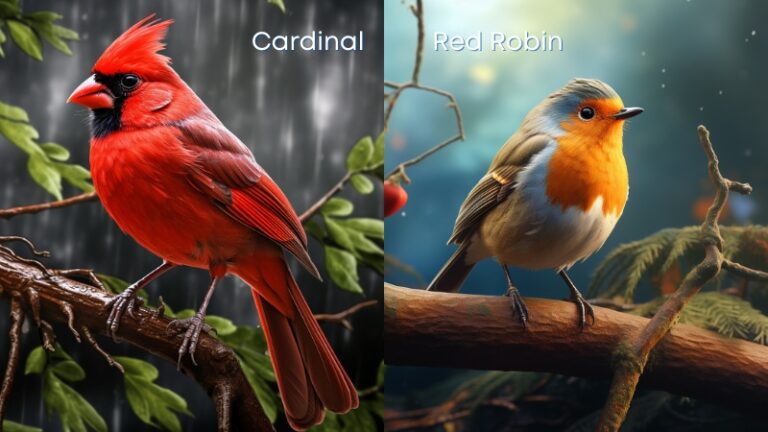How to Protect Bird Nests from Predators in 2023
Birds, as integral parts of our ecosystem, play a crucial role in maintaining the balance of nature. One of the key aspects of bird conservation is the protection of their nests from various predators.
This article aims to shed light on the importance of protecting bird nests from predators and provides practical strategies to ensure their safety.
Identifying Common Predators
Understanding the threats to bird nests is the first step toward their protection. Here are some common predators that pose a significant risk to bird nests:
Cats and Dogs
Domestic pets like cats and dogs are often overlooked as potential threats. However, they can be quite destructive, especially if they are allowed to roam freely outdoors. Cats, with their agile bodies and sharp claws, are adept climbers and can easily reach nests located in trees. Dogs, on the other hand, can disturb ground nests. Responsible pet ownership is crucial to minimize these threats.
Raccoons, Squirrels, and Other Rodents
Raccoons and squirrels are notorious for their ability to climb trees and access bird nests. They are known to eat eggs and young birds. Other rodents such as rats and mice can also pose a threat to ground nests. Implementing predator deterrents can help keep these critters at bay.
Snakes
Snakes are skilled climbers and can access nests located high in trees. They are known to eat bird eggs and can be a significant threat to bird populations in certain areas.
Larger Birds
Birds of prey such as hawks, eagles, and owls are natural predators and can pose a significant threat to smaller bird species. Other birds like crows, magpies, and jays are also known to raid nests for eggs and hatchlings. Understanding the local bird population and their behaviors can help in devising effective strategies for protecting bird nests.
In this section, we will explore bird nesting habits and how to recognize signs of predation, which are essential for effective nest protection.
Understanding Bird Nesting Habits
Birds exhibit a wide range of nesting habits, which are influenced by their species, environment, and the availability of resources. Understanding these habits can provide valuable insights into how to effectively protect their nests.
Typical Nesting Locations
Birds build their nests in various locations based on their species-specific needs and preferences. Some birds, such as robins and cardinals, prefer to nest in trees or shrubs, while others like sparrows and finches may opt for cavities or birdhouses. Ground-nesting birds like quails and plovers lay their eggs directly on the ground, often in well-camouflaged locations. Recognizing these typical nesting locations can help in monitoring and protecting nests from predators.
The Nesting Process
The nesting process begins with the selection of a suitable site and the gathering of materials for nest construction. This can include twigs, leaves, feathers, and even man-made materials like string and paper. Once the nest is built, the female lays her eggs and incubation begins. Both parents often share the duties of incubating the eggs and feeding the hatchlings once they emerge. Understanding this process can help in identifying the critical stages when the nests are most vulnerable to predation.
The Role of Parent Birds in Protecting the Nest
Parent birds play a crucial role in protecting the nest from predators. They often exhibit aggressive behavior towards potential threats and may use distraction techniques to lead predators away from the nest. Recognizing these behaviors can provide early warning signs of potential threats.
Recognizing Threats and Signs of Predation
Being able to recognize the signs of predation can help in taking timely action to protect bird nests.
Physical Signs Around the Nest
Physical signs of predation can include damaged or disturbed nests, broken eggshells, or the presence of feathers and other remains. Unusual silence around the nest may also indicate a threat.
Changes in Bird Behavior
Changes in the behavior of parent birds, such as increased agitation, alarm calls, or absence from the nest, can indicate the presence of a predator.
Presence of Predators
The direct sighting of predators near bird nests is a clear sign of threat. Regular monitoring and being aware of the common predators in your area can help in early detection and intervention.
In the next sections, we will delve into practical strategies for protecting bird nests, including safe nesting support and the use of predator deterrents.
Strategies for Protecting Bird Nests
1. Safe Nesting Support
Providing safe nesting support is a proactive approach to protecting bird nests from predators. This involves creating a conducive environment for birds to nest and raise their young.
Providing Safe Nesting Materials
Birds use a variety of materials to build their nests, including twigs, leaves, grass, and feathers. You can support them by providing safe and natural materials. Avoid offering materials like plastic strips or dryer lint, which can be harmful to birds.
Proper Placement of Birdhouses
Birdhouses can provide a safe haven for many bird species. The placement of birdhouses is crucial to ensure their safety. They should be placed at a safe height and in a location that is not easily accessible to predators. It’s also important to place them away from busy areas to minimize disturbance.
Importance of Natural Habitat
Preserving and enhancing natural habitats is one of the best ways to support bird nesting. This includes maintaining native plants, providing natural food sources, and preserving existing nest sites. A healthy natural habitat can provide birds with the resources they need to defend against predators.
2. Predator Deterrents
Using predator deterrents is another effective strategy to protect bird nests. These devices can discourage or prevent predators from accessing the nests.
Use of Predator Guards and Baffles
Predator guards and baffles can be used to prevent predators like cats, raccoons, and snakes from climbing up to birdhouses or tree nests. They can be installed on the pole or tree trunk and are designed to block the path of climbing predators.
Netting and Fencing
Netting can be used to protect ground nests from predators like dogs and foxes. Fencing around the nesting area can also deter larger predators.
Safe Use of Deterrent Devices
While deterrent devices can be effective, they should be used responsibly to ensure they do not harm the birds or other non-target animals. Always choose devices that are safe, humane, and non-toxic.
In the next sections, we will discuss the role of responsible pet ownership in protecting bird nests and when and how to intervene if a nest is in danger.
3. Responsible Pet Ownership
Pets, particularly cats and dogs, can pose a significant threat to bird nests. As pet owners, it’s our responsibility to ensure that our pets do not harm wildlife.
Keeping Cats Indoors
Cats are natural hunters and can pose a significant threat to birds. Keeping cats indoors is one of the most effective ways to protect bird nests. If outdoor access is necessary, consider creating a cat enclosure or using a leash.
Training and Controlling Dogs
Dogs can disturb bird nests, especially those on the ground. Training your dog to avoid nest areas and controlling their outdoor activities during the nesting season can significantly reduce the risk of bird nests.
4. When and How to Intervene
There may be situations where human intervention is necessary to protect a bird’s nest. However, it’s important to intervene responsibly to avoid causing more harm than good.
Identifying When a Bird Nest is in Danger
Signs that a bird nest may be in danger include visible damage to the nest, presence of predators, and changes in the behavior of parent birds. Regular monitoring can help in early detection of threats.
Safe Ways to Intervene and When to Contact a Professional
If a nest is in danger, the best course of action depends on the specific situation. For minor threats, simple actions like moving the nest to a safer location or installing a predator guard may suffice. However, if the threat is severe or involves injured or orphaned birds, it’s best to contact a wildlife rehabilitator or professional. Remember, it’s illegal in many areas to keep wild birds in captivity without a permit.
FAQs
Here are some frequently asked questions about protecting bird nests from predators:
If you find a baby bird on the ground, it’s best to leave it alone as the parent birds are likely nearby. If the bird is injured or in immediate danger, contact a wildlife rehabilitator.
To keep squirrels away from bird nests, you can use squirrel baffles or guards on trees or poles. Providing alternative food sources for squirrels away from the nest area can also help.
It’s generally best to avoid touching a bird’s nest as it can disturb the birds and may attract predators. If you must move a nest, wear gloves and wash your hands thoroughly afterward.
Signs of an abandoned nest include absence of adult birds for an extended period and cold, silent eggs or chicks. If you suspect a nest is abandoned, contact a wildlife professional for advice.
Final thoughts
Protecting bird nests from predators is a crucial aspect of bird conservation.
By understanding the threats, recognizing signs of predation, and implementing effective protection strategies, we can help ensure the survival of bird populations.
Remember, every action counts and even small efforts can make a big difference in the lives of our feathered friends.


